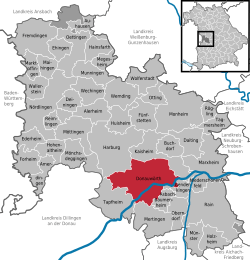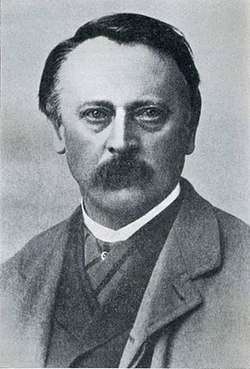Donauwörth
Donauwörth German: [ˌdoːnaʊˈvøːɐ̯t]) is a town and the capital of the Donau-Ries district in Swabia, Bavaria, Germany. It is said to have been founded by two fishermen where the rivers Danube (Donau) and Wörnitz meet. The city is part of the scenic route called "Romantische Straße" (Romantic Road)
Donauwörth | |
|---|---|
Reichsstrasse, Donauwörth | |
 Coat of arms | |
Location of Donauwörth within Donau-Ries district  | |
 Donauwörth  Donauwörth | |
| Coordinates: 48°42′N 10°48′E | |
| Country | Germany |
| State | Bavaria |
| Admin. region | Swabia |
| District | Donau-Ries |
| Government | |
| • Lord Mayor | Armin Neudert (CSU) |
| Area | |
| • Total | 77.02 km2 (29.74 sq mi) |
| Elevation | 410 m (1,350 ft) |
| Population (2018-12-31)[1] | |
| • Total | 20,080 |
| • Density | 260/km2 (680/sq mi) |
| Time zone | CET/CEST (UTC+1/+2) |
| Postal codes | 86609 |
| Dialling codes | 0906 |
| Vehicle registration | DON |
| Website | www.donauwoerth.de |
The city is situated between Munich and Nuremberg, 46 km north of Augsburg.
History
Donauwörth grew up in the course of the 11th and 12th centuries under the protection of the castle of Mangoldstein, became in the 13th century a seat of Duke Ludwig II of Bavaria, who, however, soon withdrew to Munich to escape from his wife, Duchess Maria of Brabant, whom he had there beheaded on an unfounded suspicion of infidelity. The town received the freedom of the Holy Roman Empire in 1308, and maintained its position in spite of the encroachments of Bavaria till 1607, when the interference of the Protestant inhabitants with the abbot of the Heilig-Kreuz called forth an imperial law authorizing the duke of Bavaria to punish them for the offence.[2]
It is historically important to Germany as the site of one of the incidents which led to the Thirty Years' War (1618–1648). In 1606, the Lutheran majority barred the Catholic residents of the town from holding an annual Markus procession, causing a riot to break out. During the war, it was stormed by Gustavus Adolphus (1632) and captured by Ferdinand III (1634).[2]
Donauwörth was later the scene of the Battle of Schellenberg (or Battle of Donauwörth) on 2 July 1704, during the War of the Spanish Succession (1702–1713). The battle was named after the village and high ground behind the city. John Churchill, 1st Duke of Marlborough, was marching from Flanders to Bavaria and came to the Danube. The French decided to make a crossing of the Danube at Donauwörth, where they were surprised by Marlborough's troops and after heavy fighting pulled back. That allowed Marlborough to capture Donauwörth and cross the Danube without any problem. About 5,000 French troops drowned while trying to escape. Another battle of Donauwörth on 7 October 1805 opened Napoleon's Ulm Campaign.
Notable citizens

- 1291–1351 Margareta Ebner, German mystic
- 1499–1453 Sebastian Franck, was a 16th-century German freethinker, humanist, and radical reformer
- 1838–1912 Franz Hartmann, theosophist, occultist, geomancer, astrologer and author.
- 1848–1934 Michael Deffner, philologist and archaeologist
- 1861–1933 Ferdinand Bonn, stage and film actor
- 1901–1983 Werner Egk, composer
- 1942 Werner Schnitzer, actor
- 1948 Manfred G. Schmidt, professor of political science
- 1980 Carolin Hingst, pole vaulter
- 1980 Sercan Güvenışık, footballer
Twin towns — sister cities
Donauwörth is twinned with:
See also
References
- "Fortschreibung des Bevölkerungsstandes". Bayerisches Landesamt für Statistik und Datenverarbeitung (in German). July 2019.
-

External links

- Official website


